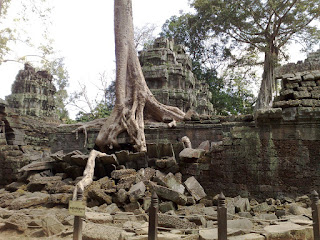I have a confession to make.
Maybe it's because I have left this a little bit too long and I didn't make any notes whatsoever and I don't have my guidebook with me at the moment - so I may have misidentified some of the temples here.
(Oh okay, those are just petty excuses for my short-term memory)
Nevertheless, here's the other half of the temple circuit. Let me know if I need to correct anything, ya?
Ruins, intentionally left unrestored.
Massive fig and silk-cotton trees growing on the temple complex differentiate Ta Prohm from others. This temple was made famous by Ms Croft. The downside of coming here during peak season is that people are everywhere snapping pictures. The polite ones give way, the rest, well, they just don't care and give a WTH look. Especially those in groups.

Huge slabs of stones form the ruins at Ta Prohm. I think the most appropriate description is 'bongkah-bongkah batu', what's that in English?

Restoration works at Ta Prohm. I noticed that the funding for the restoration at the various temples came from India, Italy, Japan and Germany. By the looks of it, these works will be undertaken throughout 2010 so if you visit this year, you'll see plenty of scaffoldings and barriers and cordoned-off areas at most of the temples.
Terrace of the Leper King. It has a double terrace wall and you walk between the walls/corridor. A persistent little girl stalked me here to ask for one dollar. She said (in halting English) that she was an orphan and was taken care of by monks and needed money to eat. I asked her if the monks fed her, she said 'not enough'.
From the west side facing the bright afternoon sun.

Its beautiful deep carvings, very detailed and in good condition. I wish I could spend longer time here examining them.
The Leper King himself. Whether he actually suffered from leprosy or it was just the appearance of his statue remains a debate.
These most likely represent elephant trunks.
Garudas.

Urm, ...I cannot remember if this was Ta Keo or Pre Rup. I think Pre Rup. I also missed pictures of Thommanom and Chau Say Thevoda, pretty little temples that sit across the road from each other.
I think this was Phimeanakas.
A giant Buddha statue - Preah Ngoc - near the Bayon complex.

Steps entering Bayon.

At Bayon, the last temple I visited before calling it a day (actually later after having some ice cream, I went back to Angkor Wat for sunset).
 Picture taken by a French lady, Marianne, who surprised me by speaking in fluent and beautifully accented Malay when I told her where I was from. She used to work with an NGO for some years ago in Rawang and misses the Malaysian food!
Picture taken by a French lady, Marianne, who surprised me by speaking in fluent and beautifully accented Malay when I told her where I was from. She used to work with an NGO for some years ago in Rawang and misses the Malaysian food! Pay to get your picture taken with them. I just sat to rest, as with many other people who I think are also ending the day at Bayon.
Late afternoon, back at Angkor Wat.
One of the guides for a Japanese group was explaining the significance of this carving on the floor of the walkway leading to Angkor Wat. I still don't know what it is. I tried looking around if there were other floor carvings, but it seems this is the only one around.
Very very tired feet finally gets to rest as I enjoyed the sunset.
























wahh. nice pics. All of them. The weather seems hot when u were there by looking at those pics though.And dusty also may be? But nice nice. Thanks for sharing.
ReplyDeleteHi JIPP - thanks :) Although it was 'winter', daytime is still quite hot, bright, and dry (hence dust). Early morning and evenings are cool and lovely.
ReplyDelete